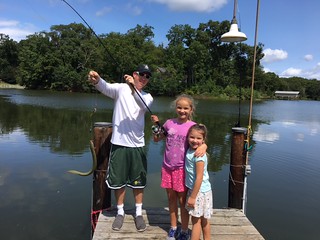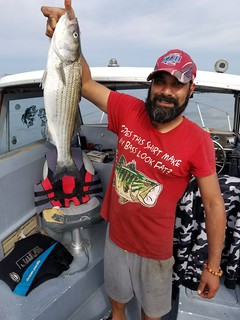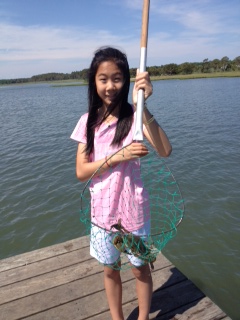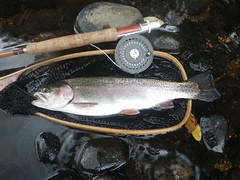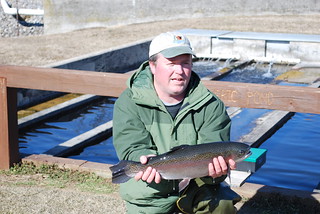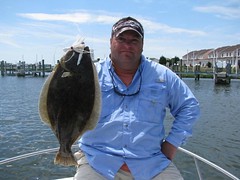Weekly Fishing Report: September 20
Many would agree we are entering one of the most beautiful times of the year in Maryland. Mornings are cool and daytime temperatures are inviting for outdoor activities. Where I live crops are being harvested, wildlife is on the move, bait in the tidal rivers is beginning to feel the urge to move out into the bay, and fish such as striped bass are enjoying the cooler water temperatures and ready to intercept the schools of bait. Some vegetation is starting to show color and the daylight hours are decreasing by about two and a half minutes a day.
Marylanders are on the move also, family schedules have adjusted to school and the weekends present a precious time to be with family and friends in the great Maryland outdoors. This is a great time of the year to visit your favorite fishing hole whether it is a creek or pond in western Maryland or just fishing off a dock in the Chesapeake Bay.
Before we get into this week’s fishing report, I wanted to remind everyone that they can submit their own fishing reports and photos to the Maryland Angler’s Log. To post a report, please email your name, hometown, photos, location information and additional content for your report. All information is optional, but encouraged. New reports are posted daily during the busy fishing seasons. You can see our most recent Angler’s Log here.
The striped bass action continues to be good this week in the upper bay. As water temperatures begin to cool entering the fall months, the fishing situation is going to change. Right now, live lining spot along channel edges is the most popular game in town. The spot are readily available at the shallower hard-bottomed areas; the shallower ends of the Bay Bridge off Sandy Point State Park and the Magothy River are just a few places to catch spot on bloodworms. The striped bass have been holding along the channel edges at Love and Podickory points and to a lesser degree at Swan Point. It pays to slowly check other edges with a depth finder to locate suspended fish.
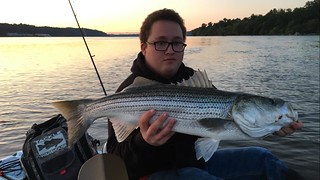
Lou Walden holds up a really nice striped bass caught in the lower Susquehanna recently. Photo by Don Goff
Trolling can be a good option with spoons, bucktails and surge tube lures behind planers and inline weights to get them down close to the bottom, where the fish are holding. Single and tandem lures will usually hold behind a planer without tripping them but umbrella rigs will need a lot of weight to get them down. More and more surface action is being encountered out in the bay as bait starts to get the hint to leave the tidal rivers. This exodus of bait will really increase next month as water temperatures fall and the best fishing will switch to vertical jigging.
The water levels in the lower Susquehanna River have been highly variable recently; at times the power generation gates do not open for a day or so making for very low water levels. A few striped bass are being caught at the dam pool and the lower parts of the river along with some impressive smallmouth bass. Near the flats some undersized striped bass are being caught on topwater lures along with some largemouth bass in the morning and evening hours.
The tidal rivers in the upper bay region are providing some wonderful white perch fishing this week. Cooler water temperatures have the perch more active in deep as well as shallower areas. Many of the same areas that are holding spot are also holding white perch, especially at the Bay Bridge piers.
Fishing for striped bass at the Bay Bridge has been good on the eastern side of the bridge along the 25-foot drop off; this has been a great place to live line spot or jig near the pier bases. The cement abutments out near the main channel as well as the rock piles are holding striped bass also. There tends to be a greater percentage of undersized fish at times but enough larger fish to make things worthwhile.
Middle bay region water temperatures are holding around 75 degrees this week and slightly cooler in the tidal rivers. There is a lot of bait moving around in the region and being swept along by currents near channel edges. Fall jigging is just starting to show signs of a developing fishery but for now live lining spot is taking center stage. The spot are easy to find in the tidal rivers and bay shores in shallow hard-bottom areas. The striped bass are eagerly waiting along channel edges, suspended at approximately 35-foot depths close to the bottom. Tolley and Thomas points have been good places to live line as has the False Channel and the Diamonds at the mouth of the Choptank River. Some are also finding action at the outside edge of Hackett’s Bar and off Poplar Island at times. Bluefish are present so they will extract their due. Elvin Phillip caught a nice striped bass near Thomas Point, seen in the adjacent photo.
Trolling a mixed spread of small Drone or Clark spoons behind No. 2 planers is a great way to target the Spanish mackerel in the region and placing small surge tube lures and bucktails behind inline weights or planers can also entice striped bass and bluefish. Some have found that it can provide some rousing catch and release entertainment to place a large spoon or two in a trolling spread for the large red drum that have been visiting the eastern side of the bay recently.
The shallow water fishery for striped bass and white perch is bouncing back due to cooler water temperatures. This is a topwater fishery for striped bass and although there are a fair percentage of sub-legal striped bass there is plenty of action and fun. In slightly deeper areas where grass is not such a problem, white perch are being caught on small spinnerbaits and spinners. Fishing with grass shrimp near structure has also been very successful.
There tends to be a lot of bluefish and Spanish mackerel dominating the fishing scene in the lower bay region this week in the main channel areas of the bay, most are trolling a mixed spread of small Drone or Clark spoons and small-surge tube lures behind. The deadly duo has been chasing schools of bay anchovies and when the bait gets swept along swift currents near the shipping channel edges mayhem tends to take place. At times there are small striped bass joining in and there is always hope there might be a few larger striped bass lurking deep underneath so jigging can be an option.
Large red drum are still being found in the general area between the Middle Grounds to the Target Ship area. At times they can be spotted by slicks and caught by jigging large spoons or soft plastic jigs. Other times they can be caught by trolling large spoons behind inline weights. Most are 40” or better so will qualify for a catch and release certificate from the Maryland Fishing Challenge and most of the Spanish mackerel being caught in the region exceed the 22-inch minimum for an Angler Award.
Speckled trout continue to entertain on the eastern side of the bay along marsh edges, stump fields and small creeks flowing out of the marshes. Casting soft plastics like Gulp white mullets or drifting pieces of soft crab are great ways to catch them. There will be some small striped bass also mixed in.
Bottom fishing for a mix of species that reads more like a menu continues to provide a lot of fun and good eating. Large spot, white perch, croaker, kingfish, speckled trout, northern blowfish and slot size red drum tend to round out quite a variety. In the middle to upper Patuxent and Potomac rivers blue catfish tend to dominate and the smaller ones provide excellent eating.
While we are on the topic of bottom fishing in the Chesapeake Bay, I wanted to give everybody a heads-up that staffers Mike Malpezzi, the Maryland Artificial Reef Initiative coordinator and Erik Zlokovitz, with recreational fisheries outreach will be working at the dockside check-in and awards ceremony for the Rod and Reef Slam Tournament Oct. 7 at Lowes Wharf Marina Inn in Sherwood. The tournament anglers will fish on three constructed and restored reefs, including the reef ball site at Cook’s Point built by Maryland Artificial Reef Initiative partners. All anglers from the public and their children and families are invited to attend. Fishing will start at 6:45 a.m. and the after-party and awards ceremony will begin at 3 p.m.. For more info and registration, please click here.
Before we get into the crabbing, freshwater sand ocean sections of the report, here is another bay conditions update and fishing forecast from the team at Click Before You Cast.
Weekly Bay Fishing Conditions Forecast Summary (Sept. 20-27, 2017)
Main bay temperatures are now averaging about 75 degrees and will continue to cool as we approach the first day of fall (Sept. 22) and continue to lose 2.5 minutes of daylight every day. Expect stable, warm, calm and sunny weather conditions for the next week with only chances of rain early next week.
While lots of Maryland waters will have adequate oxygen from surface to bottom, start your search just above the “Do not fish below this depth.” In the upper bay near Swan Point avoid fishing depths below 16 feet. At the Bay Bridge, fish above 25 feet while from the mouth of the Choptank River south, there is plenty of oxygenated water down well below 30 feet. Expect average water clarity for most of the bay except for some spots receiving water from Lower Eastern Shore tributaries. Take advantage of the above average tidal currents starting Saturday through next Wednesday as a result of the upcoming new moon (Sept. 20). In addition, the upcoming new moon will provide darker than normal nights.
For the full weekly fishing conditions summary and more detailed and up-to-date fishing conditions in your area of the bay, be sure to check out Eyes on the Bay’s Click Before You Cast. Since this is a new feature for Chesapeake Bay anglers, drop us a line with comments or suggestions.
Recreational crabbing has been very good this week and should continue in the middle and lower bay regions and relatively good in the upper bay. Recreational crabbers are seeing a lot of sooks as these girls migrate towards the mouth of the bay for the winter. Many of the jimmy crabs being caught are large and heavy. It doesn’t take many of these to fill a bushel basket and even if you can’t catch a full bushel these large and heavy crabs satisfy an appetite fairly quick. Most are reporting that chicken necks are doing just fine for bait.
Deep Creek Lake is starting to settle down from a busy summer season and providing good and peaceful fishing once again. A mix of large yellow perch and walleye can be found along deep grass. Slow trolling crankbaits is a good tactic for walleye and drifting live minnows can catch both yellow perch and walleye and everything else that likes to eat minnows. Fisheries biologist Kenny Wampler mentioned that he recently had good luck catching a mix of yellow perch and walleye by drifting along deep grass edges and jigging slowly with a 1/8 ounce jig tipped with half a nightcrawler.
A mix of largemouth and smallmouth bass can be found near shoreline structure such as fallen treetops, floating docks and thick grass. It is pretty hard to beat a whacky rigged stick worm flipped into one of these spots but with cooler water temperatures white spinnerbaits worked along the outside edges of these spots can work well also.
Western Region fisheries biologist Alan Klotz, loves to fish the Youghiogheny River and sent us this short report from his last fishing trip. “As the aquatic insect hatches dwindle down to a trickle, early fall is the time to break out the terrestrial fly patterns. Grasshoppers, crickets, caterpillars, and flying ants are at their peak abundance, and trout are eagerly feeding on this high-protein diet before the onset of cold weather. Bright sunny days in September can trigger swarms of flying ants, and if you see the ants swarming – drop everything and head to the nearest trout stream! I had some amazing fishing in the Youghiogheny River Catch and Return Trout Fishing Area earlier this week. Flying ants were everywhere, and it seemed every trout in the river was on a feeding frenzy. The best rivers to fish for trout in Western Maryland during the latter part of September are the Youghiogheny River Catch and Return Trout Fishing Area, the Savage River Trophy Trout Fishing Areas, and the North Branch Potomac River Catch and Return Trout Fishing Areas.”
Fisheries biologist John Mullican sent us a short report from the upper Potomac this week. “The river is low and clear with abundant vegetation. Vegetation fragments are making many presentations frustratingly difficult. Small tubes and worms on very light jig heads bounced over the bottom in slightly deeper areas with boulders or in pockets in the vegetation have produced smallmouth bass and walleye. Channel catfish also hide in the vegetation and can be caught from the same pockets or by anchoring just upstream and waiting.”
Many put and take trout fishermen are eagerly anticipating the traditional fall trout stocking that is planned to begin the second week of October and continue through the month. Hatchery crews have been working hard to provide everyone with a chance to get out in the wonderful fall outdoors and enjoy some trout fishing. Water temperatures are cooling down and trout in most cases will be able to survive. One factor that we cannot control is stream flows, often in the fall due to lack of rain some creeks will not be suitable for stocking trout at the time crews wish to stock them. These situations can cause trout to be reallocated to a nearby trout management area that does have good water flows or in some cases only a partial stocking takes place since there just isn’t enough water to support the full stocking. For these reasons the stocking crews cannot always guarantee an anticipated stocking. The notice to anglers that a body of water has been stocked will be posted on the trout stocking website and by the email service as soon as possible after the stocking takes place.
All who are involved in the trout hatchery program have worked long and difficult hours to bring you a fall trout fishing experience and we hope you enjoy the fall weather and colors as well as some fun trout fishing.
The many reservoirs, lakes and ponds throughout Maryland are starting to show increased fish activity as cooler water temperatures prevail. In general things have become more comfortable for all species of fish and they can now move more freely throughout their aquatic environment in search of food. Better fishing now lasts longer into the day. Casting spinnerbaits and small crankbaits near edges of grass and wood is a good tactic for largemouth bass and jigs and soft plastics are a good thing to try tight to structure. In many areas grass is starting to break up due to shorter daylight hours so sunken wood offers bass some structure.
In the tidal rivers largemouth bass are being found in transition areas such as drop offs and structure such as fallen tree tops and sunken wood in slightly deeper waters. Small crankbaits, jigs and spinnerbaits can be good choices. A falling tide will help push largemouth bass out of grass and spatterdock fields, so working these edges is a good idea. Northern snakeheads will be part of the mix in the tidal Potomac, Patuxent and Nanticoke rivers as well as the small creek areas in Dorchester County. Noisy topwater lures are hard to beat when fishing for them.
The Ocean City area will be buckling down for some rough sea conditions this weekend as Jose pushes ground swells towards our Maryland shores. This may make it tough for surf fishing and boats clearing the inlet for offshore waters. A good thing may be that our offshore waters will get stirred up a bit making for some new and exciting fishing opportunities.
It will no doubt take a lot of lead to hold bottom while surf fishing this weekend but there is a mix of kingfish, northern blowfish, small black drum and bluefish out there. At the inlet area, there has been some exciting fishing for sheepshead at the inlet, the Route 50 Bridge and particularly the south jetty. Sand fleas is the bait of choice but clams will work also. There is also a mix of red drum that often are falling in the 18-inch to 27-inch slot as well as small black drum, sea trout, triggerfish and flounder. In the evenings bluefish and a few striped bass are being caught on cut bait, live spot and by casting lures.
Flounder fishing in the back bay area channels continues to be good and this week’s success will depend on wind conditions and whether the bay gets churned up. Many that are looking for larger flounder are drifting live spot in the channels leading towards the inlet or using large baits such as white Gulp baits on a jig. It has not started yet for the most part, but cooler water temperatures later on this month and next will urge flounder to pour out of the back bay waters and out the inlet. There have also been some slot size red drum being caught in the channels also this week.
The Maryland sea bass season closes Sept. 21 and will not open again until Oct. 22. There are tautog and triggerfish at many of the wreck and reef sites and perhaps one of the biggest draws to these sites are the impressive flounder that are being caught.
The offshore fishing scene has been focused on a mixed bag of wahoo, dolphin, yellowfin tuna and white and blue marlin catches. Some of the better catches have been coming from the Baltimore and Poorman’s canyons. When the seas calm down we may well experience the traditional blitz of white marlin that often occurs in late September.
“Quite possibly this is the key to fishing: the ability to see glamour in whatever species one may fish for.” – Harold Blaisdell 1969
 ABOUT THE AUTHOR Keith Lockwood has been writing the Fishing Report since 2003 and has had a long career as a fisheries research biologist since 1973. Over the course of his career he has studied estuarine fishery populations, ocean species, and over a decade long study of bioaccumulation of chemicals in aquatic species in New Jersey. Upon moving to Oxford on the eastern shore of Maryland; research endeavors focused on a variety of catch and release studies as well as other fisheries related research at the Cooperative Oxford Laboratory. Education and outreach to the fishing public has always been an important component to the mission of these studies. Keith is an avid outdoorsman enjoying hunting, fishing, bird dogs, family and life on the eastern shore of Maryland.
ABOUT THE AUTHOR Keith Lockwood has been writing the Fishing Report since 2003 and has had a long career as a fisheries research biologist since 1973. Over the course of his career he has studied estuarine fishery populations, ocean species, and over a decade long study of bioaccumulation of chemicals in aquatic species in New Jersey. Upon moving to Oxford on the eastern shore of Maryland; research endeavors focused on a variety of catch and release studies as well as other fisheries related research at the Cooperative Oxford Laboratory. Education and outreach to the fishing public has always been an important component to the mission of these studies. Keith is an avid outdoorsman enjoying hunting, fishing, bird dogs, family and life on the eastern shore of Maryland.
Want the Weekly Fishing Report sent right to your inbox? Click here to sign up!

